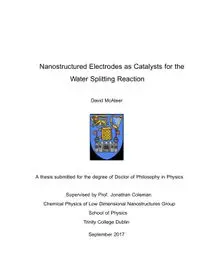
Nanostructured Electrodes as Catalysts for the Water Splitting Reaction PDF
Preview Nanostructured Electrodes as Catalysts for the Water Splitting Reaction
Nanostructured Electrodes as Catalysts for the Water Splitting Reaction David McAteer A thesis submitted for the degree of Doctor of Philosophy in Physics Supervised by Prof. Jonathan Coleman Chemical Physics of Low Dimensional Nanostructures Group School of Physics Trinity College Dublin September 2017 To Mum, Dad and Phoebe Decleration I declare that this thesis has not been submitted as an exercise for a degree at this or any other university and it is entirely my own work. I agree to deposit this thesis in the University’s open access institutional reposit- ory or allow the library to do so on my behalf, subject to Irish Copyright Legislation and Trinity College Library conditions of use and acknowledgement. Elements of this work that have been carried out jointly with others or by col- laborators have been duly acknowledged in the text wherever included. ________________ David McAteer i Abstract The production of hydrogen through the electrochemical water splitting reaction is an attractive energy storage solution for intermittent natural resources. This comprises of the hydrogen evolution reaction (HER) at the cathode and the oxygen evolution reaction (OER) at the anode. However, these reactions are kinetically sluggish and require efficient electrocatalysts. Thus, identifying cheap, yet effective catalyst materials is critical to the advancement of water splitting. Inorganic layered compounds such as transitional metal dichalcogenides (TMDs) and layered double hydroxides (LDHs) have properties that are ideal for applica- tions as high performance HER and OER electrocatalysts respectfully. Exfoliating these materials into nanoscale dimensions can serve to further enhance the activity through increasing the density of catalytically active sites. However, the low elec- trical conductivities of these material can severely hinder performance, particularly for high mass loading electrodes. In this thesis we use liquid exfoliation methods to produce large quantities of high quality two dimensional (2D) nanosheets of molybdenum disulphide (MoS2) and cobalt hydroxide (Co(OH)2). Nanosheet films are fabricated from porous, in- terconnected nanosheet networks and used as model catalytic systems to develop simple procedures for producing high performance electrodes. These procedures are general, and should be applicable to any solution-processable, nano-particulate HER or OER catalyst to maximise its activity. Initially, we demonstrate that the performance of HER catalytic films fabricated from nanosheets of MoS2 can be optimised by maximising electrode thickness. We find the current, and so the H2 generation rate, at a given potential to increase linearly with electrode thickness to up ~5 μm after which saturation occurs. This linear increase is consistent with a simple model which allows a figure of merit to be extracted. Based on the knowledge that the catalytically active sites of MoS2 reside on the crystal edges, this figure of merit can be used to characterize the activity of these active sites via their site density along the nanosheet edge. The magni- tude of this figure of merit implies that approximately two thirds of the possible catalytically active edge sites in the liquid exfoliated MoS2 are inactive. Saturation ii at high electrode thickness, partially due to poor electrical properties limits further improvement. Using this model developed for HER catalysts, we take a similar approach to maximizing the activity of OER catalysts using Co(OH)2 nanosheets. In comparison to MoS2, active sites of LDH materials such as Co(OH)2 remain ambiguous. Thus we begin by confirming the nanosheet edges as the active areas by analyzing the catalytic activity as a function of nanosheet size and electrode thickness. This allowed us to select the smallest nanosheets produced (mean length 50 nm) as the best performing catalysts. While the number of active sites per unit area can be increased via the electrode thickness, we found this to be impossible beyond ~8 μm (due to mechanical instabilities). At this point a critical cracking thickness was reached, where by further increase in material loading results in cracking and mechanical instabilities. Limitations in producing thick electrode films hinders further catalytic improve- ment. For our thick MoS2 electrodes we propose that the saturation in current at high electrode thickness is partly due to limitations associated with transporting charge through the resistive electrode to active sites. Our Co(OH)2 films on the other hand, are limited by the poor mechanical properties of nanosheet networked films. We show these issues can be mitigated by fabricating composite electrodes of 2D nanosheets mixed with 1D single walled carbon nanotubes (SWNTs). SWNTs can be prepared using the same solution processing methods as nanosheets, facili- tating the production of hybrid devices through simple dispersion mixing, coupled with vacuum filtration. This method also allows for the nanotube content to be tuneable. For MoS2/SWNT composite films we find both the electrode conductivity and the catalytic current at a given potential increase with nanotube content as described by percolation theory. Likewise, adding nanotubes to Co(OH)2 films increased the 8 toughness, conductivity and catalytic activity by ×100, ×10 and × 4.5 respectively, in a manner consistent with percolation theory. These enhancements meant that composite electrodes consisting of small Co(OH)2 nanosheets loaded with 10wt% nanotubes could be made into free standing films with iii thickness of up to 120 μm with no apparent mechanical or electrical limitations. The presence of diffusion limitations resulted in an optimum electrode thickness of 70 μm. Through further optimisations to electrolyte concentration and temperature a -2 current density of 50 mA cm at an overpotential of 235 mV can be obtained, close to the state of the art in the field. It is hoped that the work presented in this thesis can be used as a roadmap for future catalyst optimisation. In particular, applying these procedures to a high performance catalyst such as NiFeOx should significantly surpass the state of the art.
